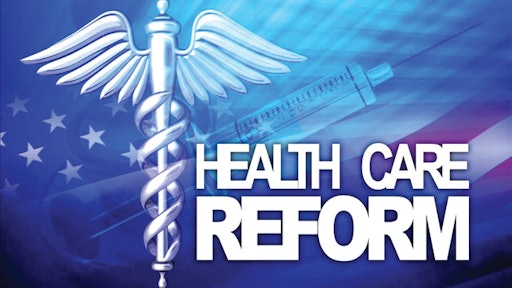
In July, the U.S. Supreme Court ruled on the major constitutional issue posed by the Patient Protection and Affordable Care Act ("ACA"), finding that the statute’s “individual mandate” requiring most U.S. citizens to purchase health insurance is constitutional. The Supreme Court upheld the new law by deeming its “penalty” to be, effectively, a "tax."
Whether you agree or disagree with the law, or the manner in which it was passed, business owners are now faced with determining whether and to what extent this new law impacts businesses and how best to prepare for it. As it turns out, the law’s effect on small businesses is fairly limited. Certainly, it will impact all of us to some degree, but as outlined below, compliance might not be as onerous as initially feared, and some of its provisions may even prove helpful.
Effects on businesses
For small businesses: Under the ACA, companies that have fewer than 50 full-time employees will not be required to provide health insurance coverage for those employees. Nonetheless, the law will have some meaningful effects for small businesses.
Among other things, the Affordable Care Act:
- Tax Credits: Permits qualified employers of up to 25 employees who pay average annual wages below $50,000, and provide health insurance, to apply for a small business tax credit of up to 35% (up to 25% for non-profits) of premiums paid.
- Coverage Denials/Preexisting Conditions: Prohibits insurers from canceling or refusing to provide coverage to employees and their family members based on health status or preexisting conditions (known illnesses). The law does not, however, prohibit insurers from charging higher premiums under these circumstances (though individual state laws may do so).
- Coverage Caps: Prohibits insurers from placing lifetime caps on coverage, and tightly limits their ability to place annual caps on coverage (after 12/31/13, the law will prohibit all annual caps).
- Eligibility Requirements: Prohibits new group health plans from establishing any eligibility rules that favor higher-wage employees.
- Aid to States: Provides financial aid (grants) to states in order to assist each state in setting up its own “Affordable Insurance Exchange” and provides aid for establishing offices of health insurance consumer assistance to help individuals with the filing of complaints and appeals.
- Limits Flexible Spending Accounts (FSAs): Limits employees to an annual contribution of no more than $2,500 to health care flexible spending accounts, and substantially limits permitted uses of FSA funds.
- Children of Covered Workers: Requires firms offering health coverage to extend benefits to children of covered workers until the child reaches age 26. The child does not have to be a legal dependent.
- Limits Benefits to Legally Documented Workers: Specifically excludes undocumented aliens from its coverage and benefits.
Beginning January 1, 2014:
- Tax Credits: For qualifying employers, the tax credits for employer-paid health insurance will increase to up to 50% of the employer’s contributions.
- Affordable Insurance Exchanges: Employers of fewer than 100 employees will be able to shop for insurance in the above referenced Affordable Insurance Exchanges, which are, in part, designed to create collective bargaining power similar to that currently maintained by larger employers.
For Medium-Sized Businesses (more than 50 employees): Under the new law, employers generally must provide affordable coverage for their employees or pay a penalty. Effectively:
- No Coverage Offered: If a company has more than 50 full-time employees and does not offer health insurance as a benefit, the company would have to pay a fee (tax) of $2,000 for every one of its full-time workers (after subtracting the first 30 employees from that assessment). Thus, an employer of 51 full-time employees would pay an annual penalty of $42,000 ($2,000 x 21) to the IRS for failing to provide affordable health insurance coverage for its employees.
- Coverage Offered: Even if the company does offer coverage, it may be required to help employees in other ways. For example:
- “Free Choice” Vouchers: Rather than participating in his/her employer-provided health insurance program, certain low-wage employees will have the option to buy health insurance from an Affordable Insurance Exchange using a “free choice voucher” provided by the employer.
- Amount: If a company offering the required coverage has at least one full-time employee receiving a federal premium tax credit (because the employer’s coverage is too expensive), the employer will be required to pay the lesser of $3,000 for each employee receiving a premium credit or $750 for each full-time employee.
Large Businesses (more than 200 employees) Automatic Enrollment: If these companies offer health insurance, they will have to automatically enroll their workers in the plan. Large businesses that fail to offer employee health insurance coverage would also be subject to per-employee penalties.
Effects on taxes
New/Increased Taxes:
- Medicare Tax Increases on High-Income Individuals: Starting in 2013, the current Medicare tax of 2.9% (divided equally, 1.45% each, between employers and employees) will rise by .9% on individual income of more than $200,000 per year ($250,000 for married couples filing jointly).
- Medicare Payroll Tax on “Unearned” Income: Starting in 2012, an additional 3.8% “Medicare Contribution Tax” will be assessed on “unearned” income (e.g., interest, dividends, annuity payments, royalties, capital gains, and passive business income) of the above referenced High-Income individuals.
- Excise Tax ("Cadillac Plans"): Beginning in 2018, insurance companies will pay a 40% excise tax on so-called "Cadillac" high-end insurance plans worth over $27,500 for families ($10,200 for individuals). Dental and vision plans are exempt and will not be counted in the total cost of a family's plan.
Here are a few suggestions for reducing your additional taxes and claiming some of the credits under this new legislation:
- 3.8% Tax on Unearned Income: The 3.8% tax on unearned income might be substantially reduced by allocating assets that generate high income into an IRA, using annuities to shield income, and/or reallocating your portfolio to include more tax-free investments (e.g., tax-free municipal bonds), which are excluded from this additional tax.
- C-Corporations: Corporations can calculate the small employer health care credit on Form 8941 and claim it as part of the general business credit on Form 3800, which they would include with their corporate income tax return.
- Sole Proprietors, Partnerships, S-Corps, and LLCs: Sole proprietors who file Form 1040, partners (in partnerships) and S-corporation shareholders who report their income on Form 1040 would also use Form 8941 to calculate the small employer health care credit and claim it as a general business credit on Form 3800, reflected on line 53 of Form 1040.
- Consider an HDHP: “High-Deductible Health Plans” (plans with deductibles of at least $1,000 for individuals and $2,000 for families) have become more popular because they offer some cost savings, while allowing for employer reimbursements of deductibles (“HDHP/HRAs”) or savings plans contributed to by employers and/or employees) to cover their deductibles (“HDHP/SOs”).
- Compare the Cost: It would be unrealistic to think that employers won’t feel compelled to compare the cost of providing coverage versus not providing coverage and simply paying the mandated penalties (“taxes”). For reference purposes, in 2011, the average annual premium for employer-sponsored health insurance plans was $15,073 for family coverage, and $5,429 for single coverage according to the Kaiser Family Foundation. Comparing the cost only makes sense.
In conclusion
Like it or not, health care reform is now a reality. Discerning how best to satisfy its requirements as efficiently and inexpensively as possible will be an important part of most businesses’ planning processes going forward. Fortunately, the U.S. Dept. of Health and Human Services has set up an informative source of information about it at www.healthcare.gov (the website is interlinked with the IRS, HHS and Department of Labor websites as well). Forewarned is forearmed. I therefore recommend starting early by reviewing the website carefully (particularly the sections for “Employers”) and contacting your tax professional regarding how best to prepare.



























